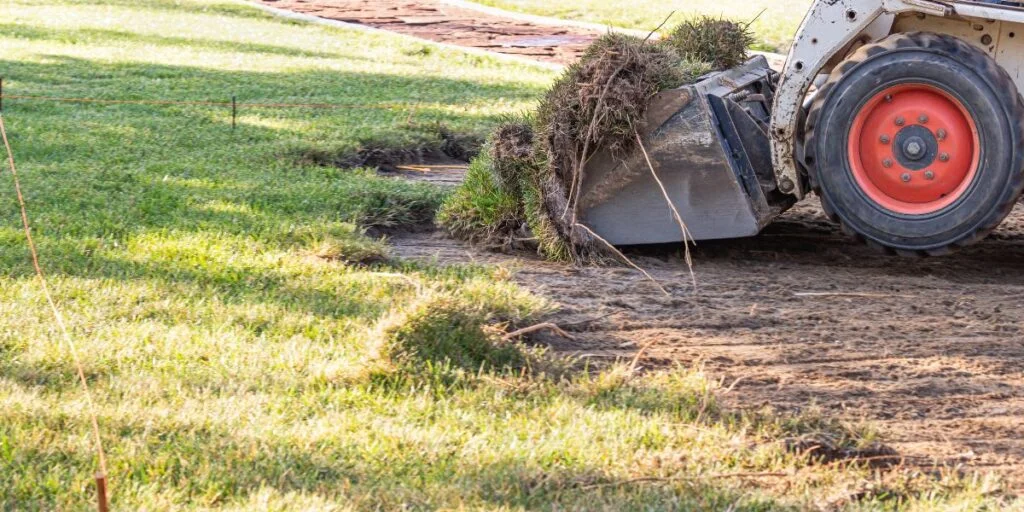As the snow melts and the first green shoots begin to push through the thawing ground, it’s clear that spring is on its way. This season is not just a time for renewal in nature but also a crucial period for homeowners to prepare their gardens and landscapes for the warmer months ahead, which can be efficiently addressed by following a spring cleanup checklist.
Spring clean-up in landscaping is an essential task that goes beyond mere aesthetics; it sets the foundation for healthy plant growth, vibrant blooms, and a lush green lawn that can be enjoyed throughout the summer. In this article, we delve into what spring clean-up entails, its key components, and why it’s a vital practice for any garden or landscape.
What is a Spring Clean Up?
Spring clean-up is a comprehensive process involving various tasks designed to revitalize your garden and landscape after the winter dormancy. It is the act of clearing away the remnants of last season, pruning and preparing plants for new growth, and making necessary adjustments to the landscape to ensure its health and beauty. This clean-up is not just about maintaining appearances; it plays a significant role in preventing diseases, and pests, and ensuring that your garden has the best possible start to the year.

The process typically begins with an assessment of the garden or yard to identify what needs to be done. This can vary significantly from one property to another, depending on the landscape design, the types of plants present, and the extent of winter damage. Once the assessment is complete, a comprehensive plan of action is formulated, covering everything from debris removal to soil care.
Key Components of Spring Clean Up Landscaping
1. Debris Removal
The first step in any spring clean-up is removing the debris that has accumulated over the winter months. Fallen leaves, broken branches, and other organic matter can smother grass, hinder new growth, and harbor pests and diseases. Carefully clearing your lawn, flower beds, and hardscapes (like paths and patios) is essential for a healthy start to the season.
2. Pruning and Trimming
Winter can be harsh on trees, shrubs, and perennial plants, necessitating a thorough spring yard cleanup. Pruning involves removing dead or damaged branches from trees and shrubs, which helps to prevent disease and encourages healthy growth. Trimming, on the other hand, focuses on shaping plants and removing old growth to make way for new buds. This not only enhances the aesthetic appeal of your landscape but also ensures that plants are in the best condition to grow.
3. Lawn Care
After a long winter, your lawn needs attention to recover and thrive. Spring lawn care typically includes aeration (to allow air, water, and nutrients to penetrate the soil), dethatching (removing a layer of dead turfgrass), and the season’s first mow at the right height. This is also an excellent time for soil testing to identify any nutrient deficiencies, followed by the appropriate fertilization to ensure a vibrant, green lawn.
4. Garden Beds Preparation
Preparing your garden beds is next. This involves removing old mulch to prevent disease and pests and replacing it with fresh mulch to retain moisture and suppress weeds. Edging the beds creates a neat, defined boundary between your garden and lawn. Additionally, enriching your soil with compost or other amendments, based on your soil testing results, will provide your plants with the nutrients they need to flourish.
5. Planting and Transplanting
Early spring is the ideal time for planting new trees, shrubs, and perennial plants, as well as for transplanting any existing ones that need a new location, making it a vital part of your spring yard cleanup. The cooler temperatures and increased moisture levels create the perfect conditions for root establishment, giving plants a strong start before the heat of summer.
Benefits of Spring Clean Up
- Enhancing Aesthetic Appeal: The immediate visible benefit of a thorough spring clean-up is the enhanced beauty of your landscape. It transforms a cluttered, winter-weary yard into a tidy, inviting outdoor space. Neatly pruned trees, trimmed shrubs, and clear, defined garden beds contribute significantly to the curb appeal and enjoyment of your home.
- Promoting Healthier Plant Growth: By removing debris, dead foliage, and overgrown vegetation, spring clean-up prevents the spread of disease and pests. Pruning damaged branches and spent flowers encourages healthier, more vigorous plant growth. Moreover, aerating and fertilizing your lawn addresses the compacted soil and nutrient deficiencies, promoting a lush, green lawn.
- Preventing Disease and Pest Infestations: The clean-up process removes the hiding spots and breeding grounds for pests and diseases. By clearing away debris and dead plant material, you minimize the risk of fungal diseases and infestations that can harm your garden and landscape.
- Preparing the Landscape for Summer Enjoyment: Ultimately, spring clean-up is about setting the stage for summer. It ensures that your garden and outdoor spaces are ready for the warm months ahead, allowing you to enjoy your outdoor space to the fullest, whether you’re gardening, entertaining, or simply relaxing.
Professional vs DIY Spring Clean Up
| Aspect | Professional Spring Clean-Up | DIY Spring Clean-Up |
|---|---|---|
| Expertise | Professionals bring expertise and knowledge about landscaping best practices. | Limited to the homeowner’s knowledge, with a learning curve for best practices. |
| Efficiency | High efficiency and speed due to experience and teamwork. | Efficiency depends on the individual’s skill and the availability of time. |
| Equipment | Access to commercial-grade equipment and materials. | Depends on personal inventory; may require renting or buying new tools. |
| Time & Energy | Saves homeowner’s time and energy, allowing focus on other tasks. | Requires significant personal time and effort, which can be rewarding. |
| Cost | Higher upfront costs for services. | Generally more cost-effective, but can vary with project scope and equipment needs. |
| Customization | Some flexibility in services offered, but generally follows a standard package. | Complete control over every aspect of the clean-up process. |
| Problem Identification | Professionals can easily identify and address potential issues early on. | Homeowners may not recognize problems until they become more serious. |
| Outcome | Consistently high-quality results, guaranteed by the service provider. | Results can vary based on skill level, but personal satisfaction can be high. |
FAQs
Q1: When is the best time to start spring clean-up?
The best time to begin spring clean-up is after the last frost of the winter season when the ground has thawed. This timing can vary depending on your geographical location. It’s crucial to wait until the ground is no longer soggy to avoid compacting the soil, which can harm plant roots. Monitoring local weather forecasts and consulting regional gardening resources can provide more specific guidance.
Q 2: How often should pruning and trimming be done?
Pruning and trimming are generally recommended during the spring for many plants, as this is right before the growing season begins. However, the frequency and timing can vary based on the type of plant. Some plants benefit from being pruned in late winter or early spring, while others do best if pruned immediately after they bloom. It’s important to research the specific needs of each plant in your landscape to determine the optimal time for these tasks.
Q 3: Can I overseed my lawn during spring clean-up?
While overseeding can be part of your spring lawn care routine, the best time for overseeding depends on your grass type. Cool-season grasses can be overseeded in the early spring, as they thrive in the cooler temperatures of fall and spring. Warm-season grasses, on the other hand, are better overseeded in late spring or early summer when the soil temperature is more conducive to their growth. Proper soil preparation, including aeration and dethatching, should precede overseeding to ensure the best results.
Spring clean-up is more than a landscaping chore; it’s an investment in the health and beauty of your home’s outdoor space. Whether you choose to hire professionals or tackle the tasks yourself, the key is to approach the process methodically and with an eye toward the future. By dedicating time and effort to spring clean-up, you prepare your garden and lawn not just for the immediate season but for the years to come.




